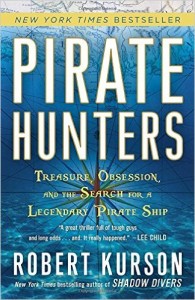Anyone want to take a guess as to the approximate time period of the Golden Age of pirates? If you guessed 1650–1720 then you’re obviously a huge nerd, but congratulations. You’re right.
We’ve all seen Pirate of the Caribbean, so we have a vivid mental image when it comes to what a pirate should look like: swarthy, with beaded hair and Keith Richards-style eyeliner. And we know how they spent their days, too: commandeering ships in order to effect dashing rescues of waifish maidens, while accumulating treasure, intrigue, and enemies along the way.
This is the point in a scholarly review where we’d normally make fun of Hollywood and its insistence on portraying all historical characters as stylish and smoking hot, but here’s the thing. Those hair beads were real. (No word on the eyeliner, alas.) That we know as much as we do about how pirates looked and lived is a testament to the indomitable obsession of men like John Chatterton and John Mattera, the heroes of Robert Kurson’s fascinating nonfiction narrative, Pirate Hunters: Treasure, Obsession, and the Search for a Legendary Pirate Ship. Well, I say nonfiction, but the book relays such a mesmerizing story and is written in such engaging prose that for quite a while, I actually thought it was fiction.
It turns out that, while exploring any shipwreck is phenomenally difficult, exploring a bona fide pirate ship adds a whole layer of impossibility to the task. This is because no one can find sunken pirate ships. In the history of diving, only one prior such ship has been definitively located: the Whydah, sailed by pirate captain “Black Sam” Bellamy, off the coast of Cape Cod. But we all know that ground zero for sunken pirate ships is the Caribbean, where a pirate infestation in the 17th century turned port cities into debauched desperado playgrounds. Pirates swarmed the seas, plundering ships and spending their ill-gotten gains in all kinds of unsavory ways, which I’ll leave to your imagination. They weren’t big savers, to say the least: these were men who lived every day as if it were their last. And it often was. Swinging from a rope was the gentlest end these guys could expect if the English caught them, but even that paled in comparison to the deaths the pirates occasionally inflicted on their victims. The descriptions of these tortures are so gruesome, I nearly vomited on my shoes while reading the book. We aren’t talking about a nice little walk off the plank here. (Men: must we idolize murderous villains all the time? Apparently, yes, we must.) No matter how you and I die, it’s going to be better than getting taken out by a pissed-off 17th century buccaneer, I promise you.(Side note, while we’re on the subject of violence: there’s an interesting section on trauma surgery, which was often performed onboard by the ship’s surgeon in the midst of battle. Most of the time, these cases were limb amputations, done entirely without anesthesia. I’ve performed plenty of amputations myself—in my capacity as a doctor, not metaphorically as a writer, although I’ve had to amputate big hunks of my ghastly writing, too, of course. But oh my gosh. The thought of cutting off someone’s leg in a dark, unsterile ship’s quarters while the ship pitches up and down and cannonballs tear through the walls is…daunting. My hat is off to the brave and skilled English navy surgeons of the era. Yikes.)
Despite their wicked ways, pirates have held an irresistible allure for centuries. Searching for these wrecks is expensive—crazy expensive—and being away from civilization for months has a predictably grim effect on marriages and normal jobs. Not to mention, deep sea diving is pretty much the most dangerous profession on earth. None of this deters Chatterton and Mattera, who are straight-up nuts. In the course of his career, Chatterton has stared helplessly into the eyes of more than one dying diver, one of them a close friend who was underwater co-filming the History Channel’s TV show Deep Sea Detectives. Mattera is no stranger to sudden death either. They’ve both led lives crammed chock-full of extraordinary events; between them, they’ve saved lives in Vietnam, made and lost millions of dollars, survived Mob hits, fought off murderous bandits, starred in television shows, and traveled the world countless times. Like many men who thrive on danger—and much like the pirates they seek—they seem immune to the risks they take every day.
When our heroes are invited on a quest to locate the Golden Fleece, a ship stolen in the 1680s by a good-guy-gone-rogue—former English sea captain Joseph Bannister—they abandon their previous plans and hightail it to the Dominic Republic. Despite its beauty, the DR has some downsides: heat and mosquitos are abundant; electricity is not. But the story of Bannister is unique: a respectable sea captain, he inexplicably stole his own ship and somehow thwarted the mighty fury of the English, more than once and under seemingly impossible conditions. When his ship was finally felled, it was after an epic battle…but where, exactly? They might be world-class divers and salvagers, but Chatterton and Mattera are also world-class history buffs. And it’s their research skills that ultimately bring them success. They log countless hours in libraries and archives in Seville, Spain, in New York City, and in the Florida Keys. They interview divers and scholars, shuffling through precious documents hand-written in centuries-old ink, seeking clues that will help them narrow their search. But it’s only when they use their knowledge to get inside the head of Joseph Bannister do they finally achieve their goal—finding the treasures of the Golden Fleece.


